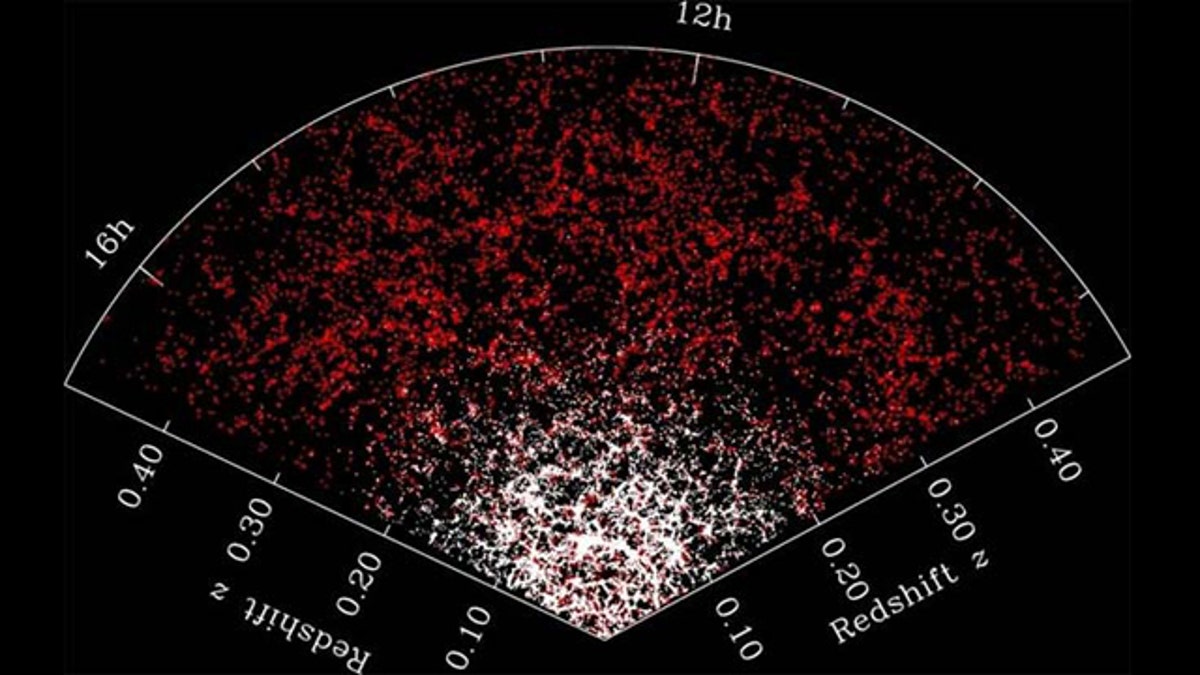
A partial map of the distribution of galaxies in the Sloan Digital Sky Survey, going out to a distance of 7 billion light years. The amount of galaxy clustering that we observe today is a signature of how gravity acted over cosmic time, and allows us to test if general relativity holds over these scales. (M. Blanton and the Sloan Digital Sky Survey)
Score one more for Einstein. A new study has confirmed his theory of general relativity works on extremely large scales.
The study was one of the first rigorous tests of this theory of gravity beyond our solar system. The research found that even over vast scales of galaxies and clusters of galaxies, the equations of general relativity predict the way that mass pulls on other mass in the universe.
The new work also helps rule out a competing theory of gravity that seeks to do away with the need for bizarre concepts like dark matter and dark energy that have irked some scientists. This research indicates those pesky ideas may be here to stay.
What is relativity?
General relativity rocked the world of physics when Einstein first published his paper on the subject in 1915. The theory built on the traditional idea of gravity based on Isaac Newton's laws, but added fundamentally new concepts like the notion that mass deforms the shape of space-time. This means that objects and even light that move through space near a large mass will travel on a curved path. Furthermore, it means that mass can stretch or shrink time as well. For example, someone watching a black hole from a distance would observe a person falling into that black hole to fall extremely slowly.
To test this theory over distances up to 3.5 billion light-years from Earth, researchers analyzed a survey of about 70,000 galaxies. The scientists combined three different measurements. First, they calculated the weak gravitational lensing caused by the galaxies – that is, they measured how much the galaxies' mass was bending light from other galaxies around them by noting the average distortion of the surrounding galaxies' shapes.
Then, they combined this data with measurements of the galaxies' velocities to learn how the galaxies were moving toward and away from one another. Finally, the astrophysicists calculated how clustered the galaxies were together over various distances. All of these measurements combined created a system to test theories of gravity independent of particular parameters in the theories.
The scientists found that general relativity is consistent with their observations of the universe at large scales. They also tested two competing theories – the tensor-vector-scalar gravity (TeVeS) idea, and another called f(R) (pronounced "f of r").
The quantities predicted by f(R) were somewhat different from those observed, but still fell within the margin of error of the measurements, so this theory is still a possibility. TeVeS, however, made predictions that fell outside the observational error limits, so scientists think they can probably eliminate this theory from consideration.
"It wasn't clear at the outset that our errors would be small enough to be able to rule out other models – it was a nice surprise," said study leader Reinabelle Reyes, a graduate student at Princeton University in Princeton, N.J.
TeVeS was already looking doubtful based on recent observations of a pair of colliding galaxy clusters called the bullet cluster, which offered strong evidence for the existence of dark matter, Reyes said. The new research offers another nail in its coffin.
Solid support
While general relativity was already pretty well accepted among physicists, the new findings offer more solid support for the theory.
"It's good to know that general relativity is consistent," Reyes told SPACE.com. "Now we have something to hold on to saying the universe really works that way."
The study was detailed in the March 11 issue of the journal Nature.
To further judge between Einstein's theory and other ideas, including f(R), research on more galaxies will be necessary to reduce the margins of error on the data.
"Reyes and colleagues' measurements are significant not just because they are consistent within error with general relativity, but also because they point the way to future high-precision tests that will better distinguish between general relativity and some variant models," physicist J. Anthony Tyson of the University of California, Davis, wrote in an accompanying essay in the same issue of Nature. Tyson was not involved in the study.
Copyright © 2010 Space.com. All Rights Reserved. This material may not be published, broadcast, rewritten or redistributed.
